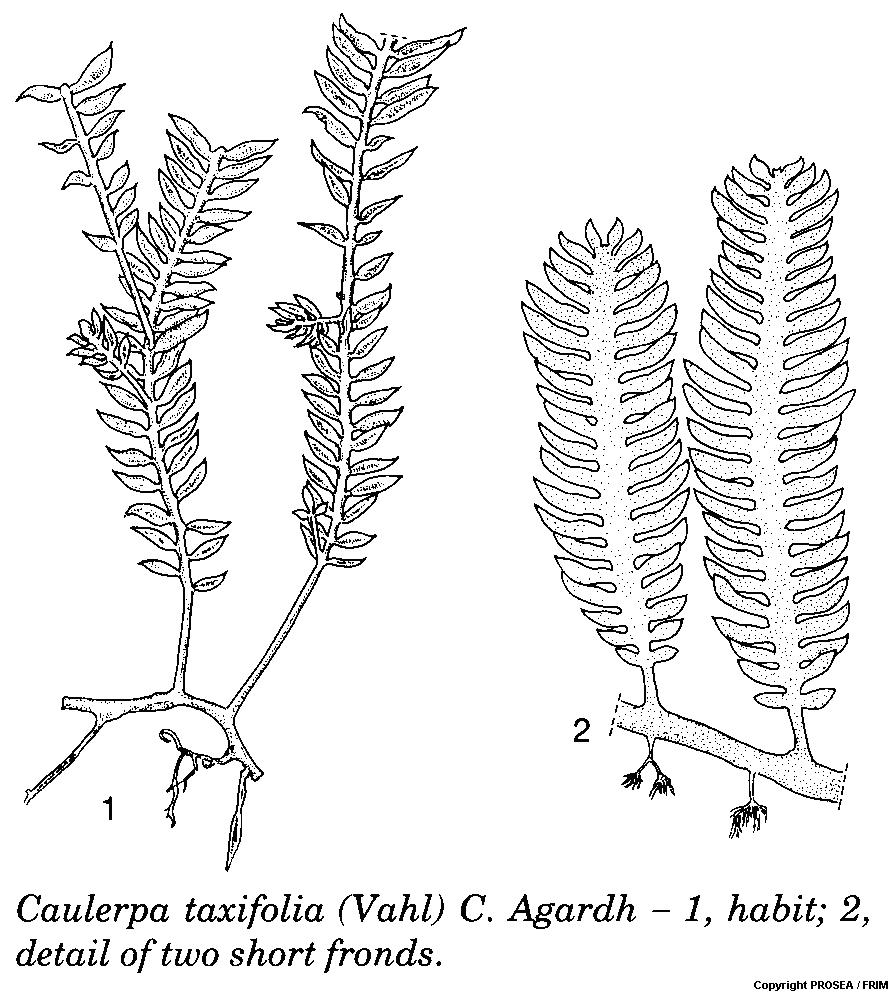Caulerpa taxifolia (Vahl) C. Agardh
Family
Caulerpaceae
Synonyms
Fucus taxifolius Vahl.
Vernacular Names
| Indonesia | Rumput laut (General). |
| Philippines | Lukay-lukay. |
Geographical Distributions
Caulerpa taxifolia is widely distributed in the tropical seas of the world and is also found in some subtropical waters, e.g. in south-eastern Queensland (Australia) and in the Mediterranean Sea where it has been introduced and is considered a pest. It is common in Southeast Asia and has been recorded in Burma (Myanmar), Thailand, Vietnam, Peninsular Malaysia, Singapore, Indonesia, the Philippines and Papua New Guinea.
Description
Caulerpa taxifolia is a stoloniferous plant. Its tubular stolon measures 0.5-2 mm in diametre. The rhizoid-bearing branches (pillars) are divided in the lower part at irregular intervals. The fronds are 6-15 cm tall (in the Mediterranean Sea, however, giant specimens of 85 cm tall have been found), often on cylindrical stalk (naked sections of the erect axis) measuring 1-3 cm long and 0.3-1 mm in diametre. The axis is usually somewhat compressed, measures 1-2 mm wide, simple or only exceptionally irregularly branched. The branchlets are borne on very short stalks. They are pinnately arranged, opposite, closely approximated, mostly not overlapping, with parallel sides and slightly constricted at their bases, compressed, measuring 3-10 mm long (3-10 times as long as broad), 0.5-1.7 mm wide and curved upwards. They taper gradually to acuminate apices and occasionally bifurcate. The thalli are holocarpic when fertile.
Ecology / Cultivation
The preferred condition for Caulerpa taxifolia in the tropics is shallow water (1-3 m deep) on semi-protected beaches with moderate current. It grows well on both hard substrate and sandy bottom, and sometimes occurs as a creeping epiphytic alga on calcareous algae or on living stony corals. Its known vertical distribution reaches to a depth of 30 m in tropical areas, and as deep as 100 m in the Mediterranean Sea. Endocellular bacteria in the cell lumen of rhizoids of C. taxifolia have been shown to take up inorganic phosphorus and organic carbon and nitrogen from substrates and translocate nutrient products to the photo-assimilatory organs. This rhizoid uptake of nutrients provides an explanation for the successful growth of these large coenocytic organisms in oligotrophic tropical waters as well as in oligotropic situations in the Mediterranean Sea.
Line Drawing / Photograph
References
- Plant Resources of South-East Asia No.15(1): Cryptogams: Algae.



